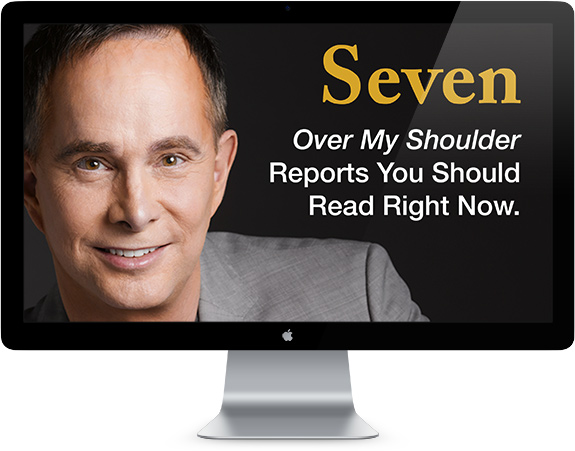You’ve probably heard of Moore’s Law, which says microchip processing power doubles every two years. I think we may have to add Mauldin’s Law. It goes like this:
The amount of “Breaking News” approximately doubles every 12 months.
OK, maybe that’s a slight exaggeration, but only a bit. Your inbox, like mine, is probably starting to look like one of those cascading tickers they once had on trading floors, back when trading floors still existed.
Worse, acting on all this news won’t necessarily help you. It might hurt you, in fact. Look how many times we see markets jump or fall based on a single tweet, only to reverse the next day.
Why are we so deluged now, and why is so much of it so useless? The answer is obvious, if you think about it for a minute.
When you flip on the TV or navigate to most news sites on the web, who pays for it? Not you. It’s free to you because advertisers foot the bill.
Ad-driven news is a perfectly legitimate business, and I know many fine journalists at the major publishers. But their bosses are the advertisers, not the readers or viewers. We don’t have to guess whose needs come first.
Or, as someone once said about Google, you aren’t the customer. You are the product. Both traditional and social media earn revenue by selling your attention.
I pay more attention to professional research firms who don’t have advertisers. Their institutional investor clients demand useful, timely, accurate analysis and will go elsewhere if they don’t get it.
That’s why I don’t rely on financial media for in-depth analysis. Yes, you’ll find a lot of good information. They’re also great for breaking news coverage.
But when your future is at stake and you need to really dig into a subject, you want a professional who works for you, not for advertisers.
Let me show you some recent examples.
We started 2018 with most everyone (including me) wondering whether this year would bring a recession. So far, it hasn’t, and I’ve since grown more convinced the recovery can persist a few more years.

My friend Ed Yardeni was way ahead of me. On May 31, we sent Over My Shoulder members a “Recession Watch List” briefing. His institutional research subscribers had received it just two days earlier.
Ed methodically ticked through five possible stress cracks in the US economy, then explained why none were causing him any alarm.
He was exactly right... and his outlook helped me make some key financial and business decisions.
Here are Ed’s key points, exactly as I summarized them for Over My Shoulder subscribers on May 31.
While Fed officials describe their balance sheet tapering and rate hikes as "normalization," it counts as tightening to everyone else. Seven years of near-zero rates make their path to 3% Fed Funds rate feel high, not normal.
Nonfinancial corporate debt rose from $2.4T to $5.3T in the current expansion, which seems troubling, but for now there are few signs of stress in the spread between high-yield corporates and long-term Treasury bonds.
The flattening yield curve reflects diminished long-term inflation expectations. If the Fed can avoid a late-cycle inflationary boom, the flat curve could be bullish for stocks, not bearish.
Higher fuel prices are adding to inflation pressure, but the Saudis appear willing to increase production to replace the amounts Iran will no longer export under revived sanctions.
This year's tax cuts will still leave many blue state residents with a net tax increase due to lost mortgage and state/local tax deductions. This may be why consumer spending and home purchases are not rising as some anticipated.
Ed’s yield curve observation was especially thought-provoking. It told him investors believed the Fed had inflation under control and they could keep lending long-term money at lower interest. Sure enough, the 10-year Treasury yield has stayed in a tight range just below 3% since then.
As for recession... not only have we avoided it, GDP growth has accelerated, with the latest official estimate showing 4.2% real growth in the second quarter.
When I sent Ed’s piece, I said in the introduction, “Bearish-leaning investors should consider his ideas carefully.” At that point, I was such an investor myself.
I took my own advice... and I’m glad I did. It helped me make better decisions.
This year’s other big fear has been a trade war, and rightly so. Global growth would be considerably lower right now if President Trump and other leaders had all followed through on their threats. Fortunately, they haven’t.
Now, predicting politicians is even harder than predicting markets. Trade war still looks closer than it has in decades. How bad would it be? Dr. Woody Brock war-gamed it and found the damage, while potentially significant, would not be as bad as more alarming estimates showed.

Here are the bullet points I gave Over My Shoulder readers on May 18, along with Woody’s full report.
Unlike in the 1930s, now some 83% of US private sector incomes are generated by service jobs, not manufacturing or farming.
Tariffs targeted against US exports will mean layoffs mostly for farm equipment and industrial robots, not human workers.
Because capital assets will stop generating income, a trade war today will hurt owners of capital more than it hurts labor.
Many US-produced goods use inputs from China and elsewhere, so tariffs on exports back to those countries may hurt their own workers more than they hurt the US.
Woody Brock's rough estimate is a significant trade war would reduce US Gross National Income by about 2%, spread over three years, far less than the 8% drop seen in the Smoot-Hawley era of the 1930s.
Woody’s balanced view struck me as quite sensible, avoiding the alarmist Smoot-Hawley comparisons while recognizing a trade war would still cause serious problems. It’s the kind of “muddle through” conclusion I’ve found is often right.
With this in mind, I’ve kept my radar tuned into trade negotiations, but I worry much less about the worst-case scenarios. This freed me to think about other, more important risks.
As you’ve read in Thoughts from the Frontline, I think liquidity (or lack of it) will aggravate the next financial crisis. Investors assume they can sell assets like high-yield “junk bonds” when trouble strikes. That’s a dangerous assumption.
My friends at Gavekal see the same risk and have been giving their clients specific strategies to deal with it. Last month, co-founder Charles Gave sent a very interesting slide deck to outline his thinking.

Charles sees a good chance the world is heading into its eighth US dollar liquidity squeeze since 1971. Here’s the summary my co-editor Patrick Watson wrote for Over My Shoulder members on August 6.
Past liquidity crises ended when the Federal Reserve intervened, but this time politics could delay any response and let problems intensify.
Presently, most of the world is moving from disinflationary boom to disinflationary bust, but the US is heading into an inflationary boom. This divergence greatly complicates portfolio strategy.
A similar setup in 1998–2000 did not end happily.
This year we see problems starting to emerge in Turkey, Argentina, and Brazil.
Continental Europe is the weakest link because it is heavily exposed to slowing trade, an unsustainable currency system and faces rising political resistance. Avoid _________.
_____ looks relatively attractive, given undervaluation and robust corporate profits. The ________ tends to rise in a dollar liquidity crisis.
Buying _______ looks like a good idea. Charles suggests selling ______ and buying ______.
(I apologize for those blank spaces. We have to reserve the specific recommendations for Gavekal clients and Over My Shoulder members. The broader point is to avoid non-US markets that depend on abundant US dollar liquidity.)
Charles identifies the key difference we have to face in today’s markets: The US and rest of the developed world are out of sync. We have a growing inflationary boom while they are in deflationary bust. This makes it hard to execute a single global strategy. You need to make fine, nuanced distinctions.
Unfortunately, fine distinctions are not what you get from most of the financial media, and even some well-known advisory firms.
Contrast the level-headed, sober analysis above with the shrill, frantic, knee-jerk commentary you see online or on TV. Which is more valuable? I think you can tell.
But there’s another problem, too.
In Over My Shoulder, we’ve solved that not-so-little problem.
Subscribers get the full report we think is important... and they get a short summary (like those above) written by Patrick Watson or me.
The summaries are less than one page and have three parts:
Why You Should Read: A couple of sentences explaining why this is worth your time.
Key Points: A bulleted summary, just like those I quoted above.
Bottom Line: The key takeaway you should get from the report.
The full piece is attached as a PDF if you want more details, but you don’t have to. That’s why 90% of members open every Over My Shoulder issue. They know that in just a minute or two, they’ll get useful investment information and get a little bit smarter, too. They can then open the PDF and dig deeper if they want.
Maybe even more important is the research we don’t send to Over My Shoulder members.
Patrick and I cull through a lot of it. We ask ourselves, is this one of the week’s 2–4 best, most unique pieces of economic research? Will they see this anywhere else?
We try hard not to waste your time, and member feedback says we’re succeeding. I’d like to help you, too, like I helped these readers.
Over My Shoulder has improved my analytical skills, and that will have a permanent positive impact on my investments." —R.A., GA
I am a better investor because of the insights I receive. Even good for cocktail party conversations!" —B.T., WA
"There is no other data accumulator that ALWAYS provides 'must-read-and-ponder' quality research. You find clear writers and clear thinkers." —J.H., TX
Knowing that John thinks these articles are worthwhile helps me to sort wheat from chaff." —J.H., CA
Over My Shoulder is the best single source of information from many of the investment industry's greatest thinkers available." —T.H., TX
The reports I quoted above from Ed Yardeni, Woody Brock and Charles Gave costs thousands of dollars. I have other sources you can’t buy at any price. They are private, not accessible to the general public.

I can send this research to Over My Shoulder members only because I’ve known the authors for years. In most cases, they don’t post it publicly or let non-clients see it. I’ve convinced them to let me share it with my readers.
This month we’re going even further with a special “Gavekal Week.” From October 8–12, we’ll share daily content from the top-rated research firm founded by Charles gave, Anatole Kaletsky and Louis Gave.
Why are we doing this?
Gavekal’s special insight into China is critical for us all right now so I’ve asked them to let me share even more analysis than usual. They graciously agreed and, as an Over My Shoulder member, you’ll get full access (and it won’t have blanks like the Charles Gave excerpt above).
As you’ve read in Thoughts from the Frontline, I’m bullish on the economy for now but I see some tough times coming. I want all my readers to be ready. Reading Over My Shoulder will help you prepare with relevant, well-vetted research from some of the best minds in the business.
With their help, I’ve refined my own outlook. I think the recovery can persist another year or two but then we’ll enter a crisis, culminating in the debt liquidation event I call the Great Reset.
My strategy now is to use these good times to prepare for the bad ones. I want you to be prepared, too. Over My Shoulder is an important tool I want to share with you.
I’ve tried to help further by keeping the price extraordinarily low, considering the value members receive. With Over My Shoulder you’ll get:
3–4 pieces of research each week (occasionally more if required) from today’s great economic thinkers. They’ll be carefully vetted by Patrick and I, and arrive in your inbox with accompanying notes, takeaways, and summaries.
Access to seven years of archives, including pieces from Stanley Druckenmiller, Grant Williams, Howard Marks, Ben Hunt, Lacy Hunt, David Zervos, Niels Jensen, Neil Howe, David Kotok, Robert Shiller, and many, many more.
The weekly Charts That Matter supplement.
Red-carpet preferred access to Gavekal Week.
That’s a fantastic deal even at the normal $14.95 monthly rate... but right now you can pay even less. Join by October 8 and you’ll pay only $9.95 for this wealth of useful information.
That’s a 33% savings, just $2.30 per week for three to four pieces of research which by themselves could cost you thousands of dollars, if you can get them at all.
No matter what the fee is for new members in the future (and once you join, you’ll see it is worth much more than this limited-time offer of $9.95 per month), your membership fee will never change.
I’m confident you’ll agree this is a truly wonderful deal.
Another point—there is no “minimum term” of membership, or any other hidden terms or conditions. If you decide Over My Shoulder isn’t for you, you can cancel at any time and you will not be charged your next month’s membership.
The Over My Shoulder archives are a research treasure trove. As a member, you’ll be able to browse them at your leisure.
But, I know that can be a challenge, too. Where to begin?

To help, I’ll send you an exclusive special report: Seven Over My Shoulder Reports You Should Read Right Now.
Picking these was tough because everything we send is so good. I urge you to read as much as you can. But these seven 2018 issues are particularly valuable and timely, in my opinion.
You’ll get the list automatically if you accept this limited-time offer by October 8, with one-click direct links to those archive pages. You’ll be able to read our summaries and the full reports as well.
Click here to join nowThank you for reading, and thank you for all of your support. I truly do appreciate it, and hope that Over My Shoulder will help fulfill your needs as we move through these tumultuous times.
Your excited to see you looking over my shoulder analyst,

 |
John Mauldin Chairman, Mauldin Economics |
 © 2018 Mauldin Economics, LLC.
© 2018 Mauldin Economics, LLC.